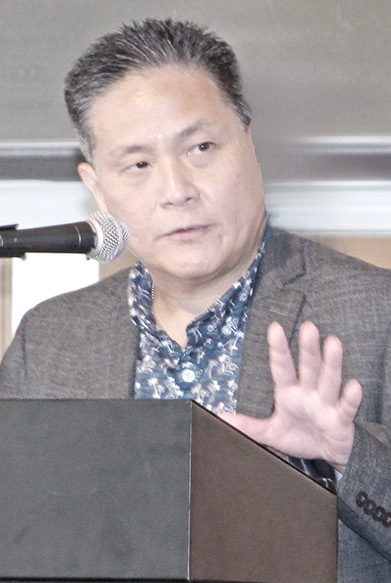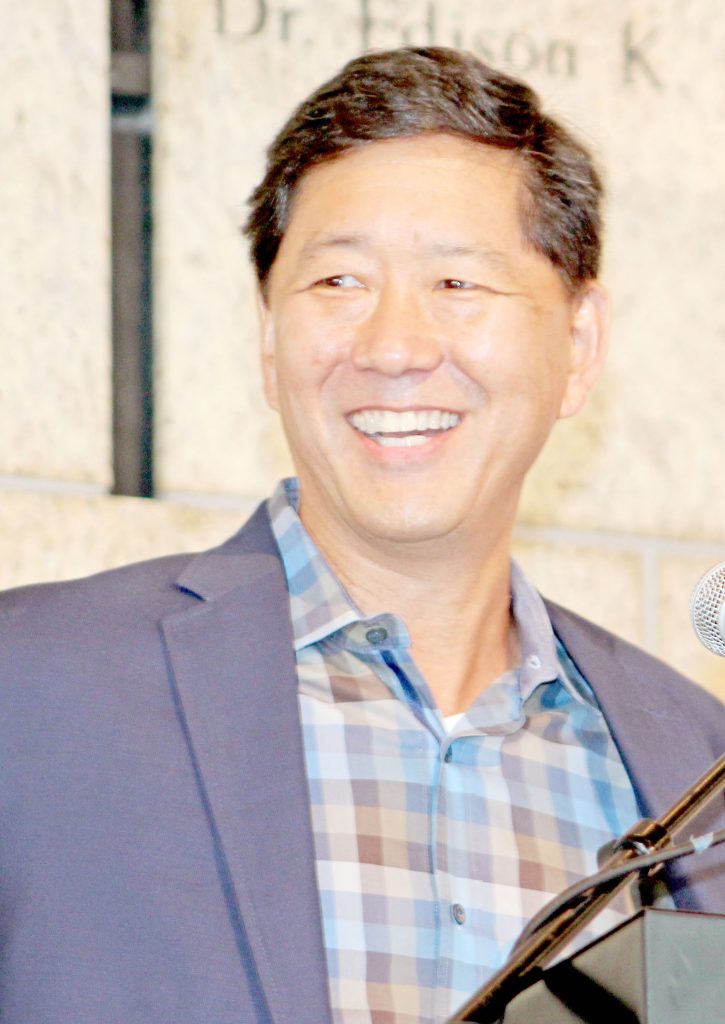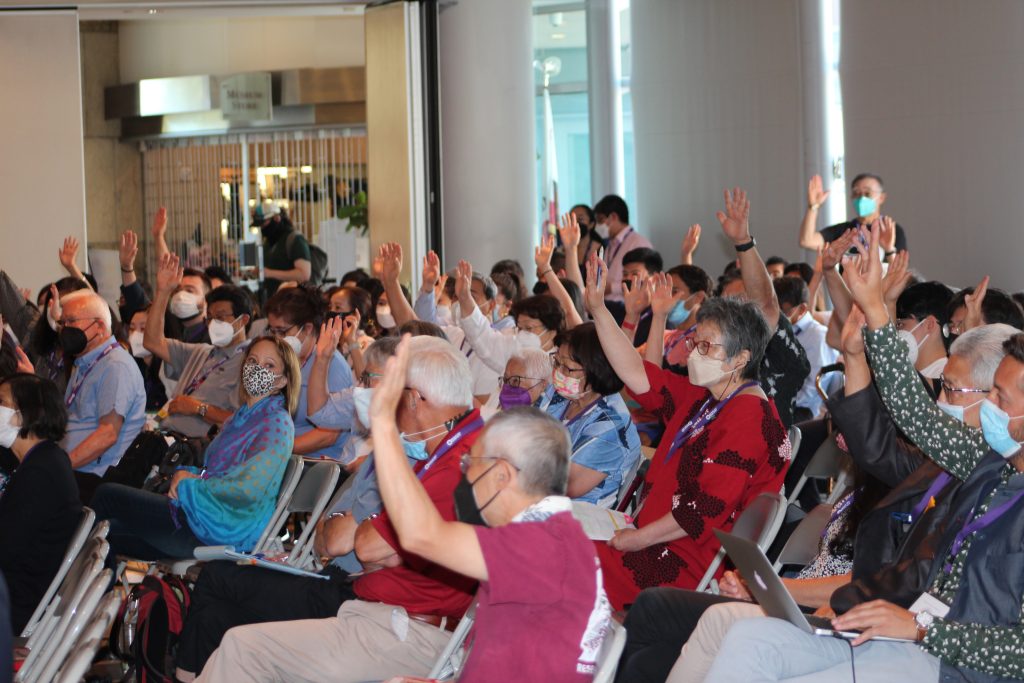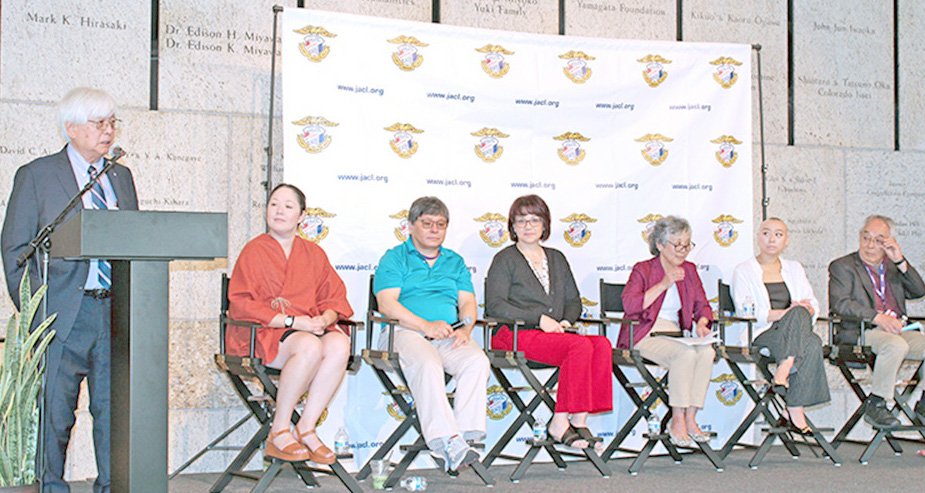JACL National President Larry Oda (left) addresses the audience as panelists Lisa Doi, Sheldon Arakaki, Lisa Shiosaki Olsen, moderator Susan Kamei, Mika Chan and John Tateishi listen. (Photo: George Toshio Johnston)
Convention’s first of two plenaries plots course on adapting to a changing landscape.
By P.C. Staff
Future historians may note that the first step toward “Envisioning JACL’s Future Together” — which happened to also be the name of the July 21 plenary session at last month’s JACL National Convention in Los Angeles — took place at a different venue than what was listed in the printed convention guide.
The change, necessitated by a hotel workers strike and aided by a last-minute cancelation that freed up the main hall of the Japanese American National Museum, was a fitting example of how the Japanese American Citizens League must be flexible and adaptable as it figures out how to grow and remain relevant amidst membership declines, last year’s lack of interest by members to serve as national officers and ever-present fiscal challenges in the run-up to the organization’s centennial.
Serving as moderator for the discussion was Susan Kamei, former JACL national deputy legal counsel and member of the JACL’s legislative strategy team during the redress campaign and author of 2021’s “When Can We Go Back to America?: Voices of Japanese American Incarceration During WWII” (see Pacific Citizen, Sept. 10-23, 2021), who is also the managing director of the Spatial Sciences Institute at University of Southern California’s Dornsife College of Letters, Arts and Sciences and professor of the USC course titled “War, Race and the Constitution.”

JACL National VP of Planning and Development Gary Nakamura makes his opening remarks during the plenary titled “Envisioning JACL’s Future Together” in the main hall of the Japanese American National Museum on July 21. (Photo: George Toshio Johnston)
Preceding the Kamei-led discussion was an address by JACL National President Larry Oda, followed by remarks from JACL VP of Planning and Development Gary Nakamura of Houston and Michael Kanazawa, a member of California’s Contra Costa JACL chapter and partner for Innovation and Transformation at the accounting firm EY.

Michael Kanazawa shares a smile with the audience during his presentation. (Photo: George Toshio Johnston)
Alluding to the actions taken by both the Twin Cities JACL chapter in the aftermath of the police killing of George Floyd and his Houston JACL chapter with regard to bills aimed at barring real estate purchases by Chinese nationals and others, Nakamura told the audience: “The purpose of this new vision initiative is … to help JACL to continue to be relevant and thrive another 100 years.”
Up next was Kanazawa, who took the opportunity to share “a little bit about what visioning is all about.” Using slides to bolster his address, he assured the audience that “visioning isn’t about anything radical, it’s just taking steps forward.”
Attributing to the Iroquois the concept of looking backward and forward seven generations before making an important decision, Kanazawa said, “The thing about visioning is this: If you get fixated on just the one thing that you’re concentrating on — for us that would be ‘What does JACL need to be in the future?’ — you kind of miss something about what the right answer is.”
Participating in the Kamei-led panel discussion were Sheldon Arakaki, Pacific Northwest District governor; Mika Chan, National Youth chair; Lisa Doi, Chicago JACL chapter president; Lisa Shiosaki Olsen, Intermountain District governor; and John Tateishi, former JACL national director and redress campaign strategist.
After answering a query about what JACL meant to each panelist, with answers ranging from serving and giving back to the community, Kamei followed with the question of whether the status quo for Japanese Americans and Asian American-Native Hawaiian-Pacific Islanders is better today than in the past?
“Things are much, much better today for Asians in this country than it was 20 years ago or even 15 years ago,” concluded Tateishi.
Kamei then polled the audience to respond with a show of hands to questions like: Will the future membership of JACL be A) much more diverse; B) somewhat more diverse; C) the same as today; or D) less diverse.

Audience members raise their hands while answering a poll question. (Photo: George Toshio Johnston)
Addressing the panel, Kamei asked, “What is one group of people not in JACL or are not often in JACL today who you think should be part of it in the future?” To that, Arakaki answered, “Center-right voices need a little more diversity on the spectrum,” and that the organization needed more “income diversity.” In a general sense, Chan added, “I would like to see the JACL become much more diverse.”
Kamei then addressed to Doi the question: “What would you imagine the JA-Asian American-Native Hawaiian-Pacific Islander experience to be and what do you hope for 20 and 30 years into the future?”
Doi answered that first, “JACL needs to be very clear about what our values are” and that to be open to “a wide range of people,” JACL must offer “spaces for people to try things that don’t work out, try things and fail” — but still let members know that “they’re still welcome and held in community.” Chan added that she thought there was “a really big growth opportunity” for JACL.
Following Kamei’s discussion, Kanazawa added that the next steps for envisioning JACL’s future will be a “period of deep listening and not making decisions, not jumping to conclusions, just listening.”




